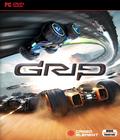In the 1990s, combat racing was a pretty big thing. The 16-bit consoles had the likes of Rock 'n Roll Racing and Road Rash. The PC had Death Rally and POD: Planet of Death while the PlayStation had Rollcage. Before that generation ended, though, the combat racing genre had all but disappeared save for an appearance or two as a lesser mode in various car combat games. Like other genres that have seemingly come and gone, the combat racing genre is slowly but surely making a return, and one of the games leading the charge is Grip.
The advantage of Grip is that it acts as a spiritual successor to one of the classic combat racing games, namely Rollcage. With a few of the original developers on board, the game adopts some of that series' hallmarks. The racing feels fast enough, so you'll want to react more quickly to turns and obstacles in your path. There's a good balance of power-ups and weapons, and while none are unfamiliar, they feel rather solid overall. The game also keeps the original car designs from Psygnosis' title, with the car body suspended in the air by tires so large that it can land upside-down and still be drivable; it also gives you the ability to drive on walls and ceilings.
Currently, the game has three modes in either solo or two-player offline multiplayer, with the option to split the screen horizontally or vertically. Race is exactly what it sounds like as you go up against AI opponents in a set number of laps and hopefully come out as the winner. At the moment, the AI does exactly what's expected, and there's no feeling of rubber-banding. The track design is interesting in that there are almost always two different routes to take, so you can diversify your surroundings with every lap you take. The freedom to ride on any surface and the increased chance of landing safely on your wheels mean that you have a better chance of your races flowing smoothly. Having said that, there are more obstacles on the track that will not let you pass through, so you'll hit reverse fairly often if you're not yet adept at the controls. It is a balancing act that feels weird at first, but we'll need to see more tracks to determine if it was the right move.
In Arena mode, the formula is placed in a car combat scenario. There's a visible life counter and no way to regenerate your health, so the action is tense. The weapon sets are the same as in the racing mode, so those comfortable with the Race mode won't feel alienated here. The mode works fine, but currently, you can't take advantage of the environment or your car's abilities to defy gravity, so it feels rather pedestrian for now.
The final mode thus far is Playground, which mimics Stunt mode from the PSP version of Rush. You're tasked with finding all of the orbs in a level, but you're not just dealing with a flat, open space. There are loads of ramps to help you make jumps, but there are also lots of walls, loops and tight spaces that you'll be forced to drive through since a number of orbs are located on ceilings and stuck on walls. You'll get disoriented rather quickly if you don't ease into the ground-to-ceiling transition, but the freedom to drive on almost any surface makes the experience worthwhile.
It should be noted that Grip is currently in Steam Early Access. The title screen mentions that the available build is in pre-alpha, and it certainly shows when you see the current content. Most of the levels are still works in progress, with the Playground stage still sporting some default textures from prototyping the levels. The roster of power-ups is small, and the vehicle lineup is even smaller; only two cars are available, and no stats are given for either one. There's also a lack of some basics, such as key rebinding, so players using a controller can't reset themselves on the track like keyboard players can.
At the same time, what is present looks good so far. The car designs have a futuristic appearance that is functional and rough rather than clean and beautiful. There aren't many particle effects to wow the player like there are in other games using Unreal Engine 4, but what's here seems to be smartly used instead of going overboard. It maintains a solid 30fps on a GeForce GTX 760 with Ultra settings, so it is very playable for those who haven't upgraded their cards but don't want to drop quality settings to achieve the coveted 60fps. The music is also sparse, but the drum and bass tracks fit nicely with the game's setting and vibe.
As it stands now, Grip has loads of promise. It sticks to the Rollcage formula and does so well enough that fans are pleased with it in this early stage. The presentation is good thus far, and the early modes and stages do a good job of showing that the team knows what it's doing. There's still plenty of time to go before the title is close to being ready, but those craving some combat racing should definitely keep an eye on Grip.
More articles about Grip: Combat Racing











 Grip is a futuristic combat racing game that has competitors battle across diverse landscapes of distant worlds.
Grip is a futuristic combat racing game that has competitors battle across diverse landscapes of distant worlds.


























